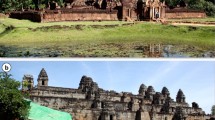Abstract
This paper presents the results of recent research dealing with the effect of fire and high temperature on sandstones of historical monuments. Sandstone buildings and their protection and restoration are nowadays in the focus of interest. Natural disasters like fire can strongly damage or even may ruin these ancient buildings. Fire disaster related changes in the petrological and petrophysical properties of the building materials can often lead to stability problems. Sandstones (seven German and three Hungarian types) with different cement types have been studied. First the forms of fire damage are demonstrated, which are: change in colour, spalling, scaling, cracking, rounding off the edges, disintegration. The petrological (polarizing microscope, X-ray, SEM) and petrophysical (density, porosity, water adsorption, ultrasonic sound velocity, duroskop rebound, uniaxial compressive and indirect tensile strength, colour measurement) investigations have shown that the texture and mineral composition of sandstones are changed by heating. These changes influence the strength and durability of stone material. It was observed that sandstones of different cement types show various features to fire. The comparison of these results provides useful information when replacing historical stone material, or one has to choose the suitable restoring method for the damaged part of sandstone buildings.
Similar content being viewed by others
References
G.E. Bessey, “Investigations on Building Fires, Part II. The Visible Changes in Concrete or Mortar Exposed to High Temperatures,” London, National Building Studies, No. 4, 1950, pp. 6–10.
B. Chakrabarti, T. Yates, and A. Lewry, “Effect of Fire Damage on Natural Stonework in Buildings,” Construction and Building Materials, vol. 10, no.7, 1995, pp. 539–544.
BRE, “Repair of Damaged Buildings-The Repair of Stone-work Damaged by Fire,” Garston BRE Note, No. 21, Building Research Establishment, 1945.
B. Chakrabarti, “An Assessment of Effects of Fire Damage to Stone in Buildings and Procedures for Restoration and Conservation of Stone in Some Historic Stone Buildings,” BRE Note, N 15/93, Garston, 1993.
A. Kieslinger, Zerstörungen an Steinbauten, Leipzig und Wien, Franz Deuticke, 1932.
M. Hajpál, “Behaviour of Sandstones of Historical Monuments under Thermal Influence,” Periodica Polytechnica, vol. 43, no, 1999, pp. 207–218.
F.J. Pettijohn, P.E. Potter, and R. Siever, Sand and Sandstone, New York, Springer Verlag, 1987, pp. 553.
Author information
Authors and Affiliations
Rights and permissions
About this article
Cite this article
Hajpál, M. Changes in Sandstones of Historical Monuments Exposed to Fire or High Temperature. Fire Technology 38, 373–382 (2002). https://doi.org/10.1023/A:1020174500861
Issue Date:
DOI: https://doi.org/10.1023/A:1020174500861




